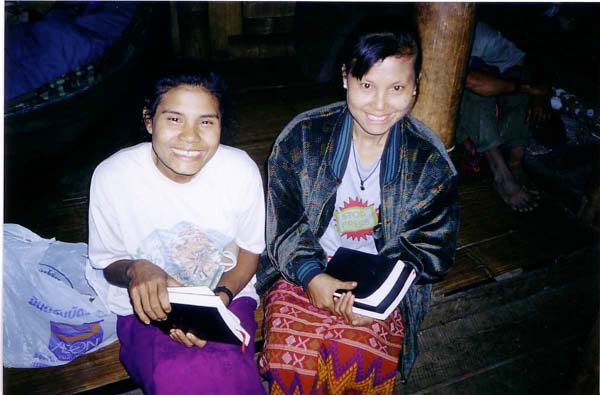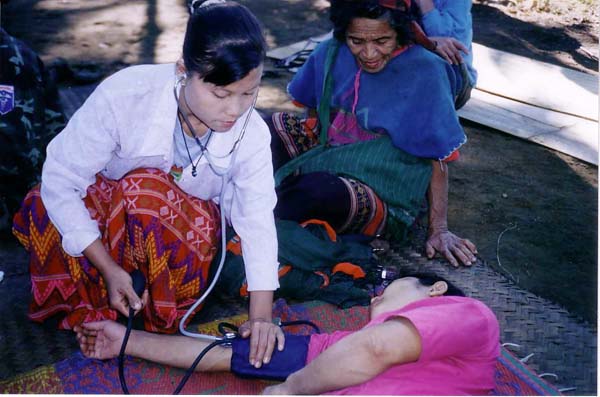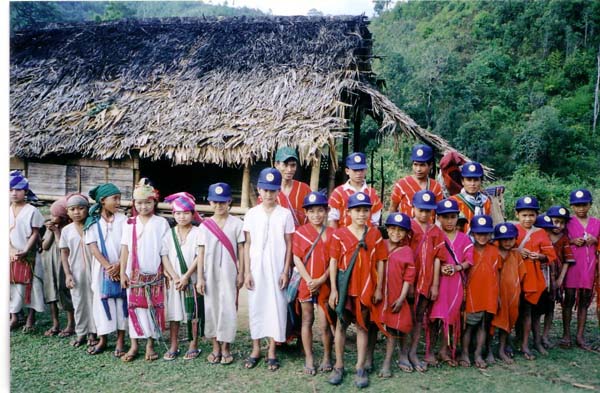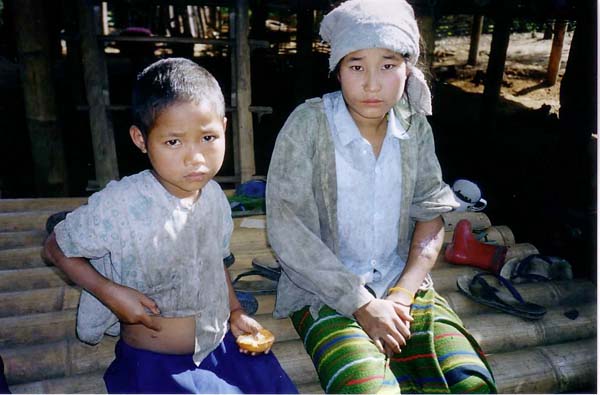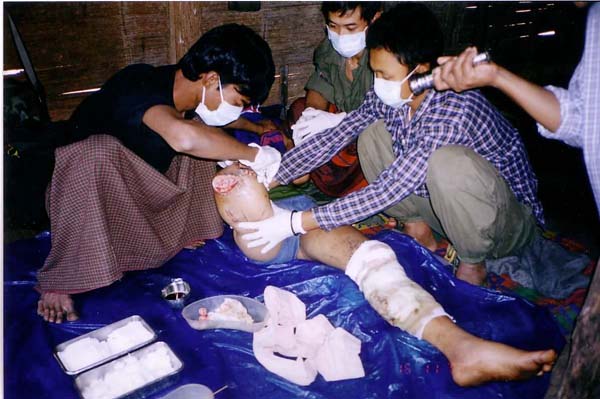|
December 30, 2002 – December 31, 2002: Infil-seventeen hour foot movement. January 1, 2003 The team traveled to first IDP village of Paw La Der. Location: N 18 18 12 E 097 24 11 Elevation: 732 M Four hour walk from Mae Nu Hta, ( a Karen village on the Salween River) The Burma Army-(One Battalion) has an outpost that is located two hours away by foot. This village has been burnt down in the past and the villagers have had to flee numerous times. There is one School here with one teacher and 20 students and a curriculum that goes up to the 5th Standard (Grade). The team set up the specially designed back- pack dental chair from ITEC and treated two women by extracting painful decayed teeth and one young girl was given a filling to preserve her tooth. Ended with prayer and song. January 2, 2003 The Team moved to Day Paw Hta. Met with the teacher (Saw Buh Wah) from the primary school which has 12 students attending. This school was started in 2002 : K – Second grade. Continued through the villages of Hta Kwee Kyo, Way Naw Do and Pa Dare Do and arrived at the village of Tha Oo Der at 7 pm. team attended the Karen New Years worship programs at the church. There is one primary school here. January 3, 2003 Departed the village of Tha Oo Der , walked for 1 and ¸ hours to the Village of Tha Dah Der . Location: N 18 24 01 E 097 16 10 Elevation: 806 M The village has one school with a curriculum that teaches K- 10th grade. There are 15 teachers and 147 students. The school serves two other villages besides Tha Dah Der. Distributed Day of Prayer news letters and five booklets titled “Shapes and Colors Counting Book”. There is one Church and one pastor. The Burma Army out post of Maw Jo sits on a hill only three kilometers away and the nearby village of Tha Oo Der was burned down by the Burma army in 1997. All of the houses and the church at that time were constructed of solid wood. Today only three houses and the rebuilt church are made of wood the rest have been rebuilt out of bamboo. An east-west car road controlled by Burma Army is a 30 minute walk away. January 3, 2003 Tha Dah Der Village The medics, pastors, dentists and human rights reporters spend the day sorting and dividing all supplies that will be sent on across the car road before the team goes across. There are four treatment areas, two located across the east-west Car Road and two located on the west side of the north-south car road. head medic goes into the village to check on reports that there are many children that are ill. Reports back that there is a possibility of a measles epidemic in the village. (treated three cases of measles) Other team members practice songs to share with the IDP children. January 4, 2003 Tha Dah Der The Karen leader and his soldiers who would take us across the car road arrived. Meeing with Mah Law. He was born in 1930 in the village of Tha Dah Der and has worked all his life for freedom for the Karen people of Burma. Allied with the British, the Karen fought against the Japanese during World War Two. Mah Law joined the fight at the age of 13. His father was Di Gay, who fought with Major Seagrim (Grandfather Longlegs), and the British during WWII. Mah Law joined the Karen revolution and the struggle for independence in the 1950s at the age of 19. Although he is now 73 years old, he continues to work hard for his village and his people and inspires many young men and women to not give up the fight for freedom. He took very good care of the Free Burma Rangers and encouraged them and thanked them for coming to help the Karen IDPs. Sunday January 5, 2003 Sunday Worship Service at the local church with villagers, soldiers, teachers, and young people. Romans 8:35-39, 14: 7-23 Sermon; “When you must choose between your heart and duty, choose duty”. Team gathered to talk and pray. Each member of the team asked for specific prayers and prayed for faith, humility, a closer walk with God, forgiveness of our sins, guidance in serving the people, energy and Love, and the future. Received reports concerning SPDC activities and human rights abuses that will be verified after crossing the car road: 1. March 25, 2002 : “SPDC entered Htee Nya Mo Hta, the place where the IDPs are staying. The SPDC shot the civilians and killed one woman Naw Sher Roe Wah and injured another woman, Naw Roe Leh. The SPDC also burned down two barns. This happened in the They Kee Area.” 2. April 3,2002 : “The SPDC entered Saw Kae Khi IDP place and shot and killed a civilian woman, Naw Moo Dah Paw. She was pregnant and gave birth just before she died. Because all the villagers were forced to flee they did not return to the area for five days. When they returned they found that the baby had also died. The SPDC also burned down one house. These incidents happened in the They Kee area.” 3. April 3, 2002 : ” Another group of SPDC shelled the IDP place called Htee Kau Day. No civilians were injured but the SPDC burned seven civilian rice paddy fields, and burned down one small building in the forest where the villagers had hidden their supplies and possessions. This happened in the Thaw Tu Kyi area.” 4. April 24, 2002 : “The SPDC shelled the IDP place called Kau Wah Plaw, but no civilians were injured. Then the SPDC burned four civilian rice paddy fields. This happened in the Tha Tu Kyi area.” 5. June 4, 2002 : “The SPDC shot and killed two civilians at Htee Kler Plaw. The two men that where killed were Saw Day Gay and Saw Htoo Three. This happened in the They Kee area.” 6. June 7, 2002 : “The SPDC shot at civilians at They Kee but did not injure anyone, but after the civilians fled the area, the SPDC burned down one IDP hut.” 7. October 30, 2002 : “SPDC light Infantry Battalion from the 101 Division/ 235/ Captainâs Name: Aung Khin, entered into Ler Mu Plaw area, Luthaw Township, Muthraw district, at the farm house known as Yu Oh Leh Hta: The Burma Army attacked:” 1. Saw Ray Bee Wah, 35 year old man, shot and killed. They also shot and injured five other civilians as they were running away: 2. Saw Sheen Nay Htoo, 17 year old boy, grazed in the forehead by bullet. 3. Saw Ti Tu , 18 year old boy, shot in the wrist 4. Naw Moo Dee Wah, 8 year old girl, shot in the stomach ( team were told that she had died but new reports indicate she is still alive. team will try to confirm.) 5. Naw Ler Per Law, 15 year old girl, shot in the arm. 6. Saw Thay Do Wah, 38 year old man, shot in the leg.” January 6, 2003 Departed Tha Dah Der village and traveled on foot with seven medics, two pastors, two dentists, two camera men and human rights documenters, as well as 20 Karen soldiers, Karen leaders and several porters. The soldiers cleared land mines and the team crossed the car road with out incident, continuing to the IDP site of Panay Eh Plaw Ko. Location: N 18 30 51 E 097 08 45 Elevation: 786 m. En route the team treated patients and visited the school at Htee Ler Khee.Here there used to be a middle school here but it had been burned down by the Burma Army in 1997 only the primary school had since been rebuilt. The head teacher asked for Childrenâs song books in English and Karen as well as basic English language books, cassette recorder and tapes. Team gave B. 1,000 to the school. January 7, 2003 Village: Pay Nah Aie Pu Koh The team set up the medical and Dental clinic area: In addition to the medics two women Nurses joined in and treated patients. (They would continue with the team until January 17,2003.)There names are Thramu Meow Htoo and Thramu Lebaw Say. Number of Patients: Medical: 350 patients treated. Most common problems were: malaria, diarrhea, acute respiratory infection (ARI), dysentery, anemia, hepatitis, liver disease, beri- beri, malnutrition, vitamin deficiencies. Special Cases: (severe eye problems in young children, with some childrenâs vision severely impaired, some blind others with cataracts.)
Dental: 22 patients, all extractions. Children’s Activities: pastor and head nurse directed children in learning Karen and English songs. team also sorted relief supplies three ways: One set of supplies for IDPs at the Ler Kee IDP site, one for the terminal objective at the IDP site of They Kee and one to treat IDPs along the way. Schools: One primary school with curriculum K – 5 : 32 students and 2 teachers. One Primary school with curriculum K – 5: located across the Yunzalin River. 35 Students and 2 teachers. SPDC Activities: SPDC came through this area in 1999, the villagers fled and the Burma Army troops slept in the village, ate the villagers food and burned down the homes. The villagers returned and rebuilt after the SPDC troops left. January 8, 2003 Village: Too Pu Hta Population: Saw Mu Plaw Village Tract: 17 Villages 526 families = 2989 Located 1hour walk across the Yunzalin River, South of Pay Nah Aie Pu Koh The Team set up a clinic to treat medical and dental patients Medical Patients Treated: 360 Patients. Most Common Problems treated: Acute Respiratory Infection (ARI), malaria, anemia, diarrhea/dysentery, Urinary Tract Infection (URI), worm infestation, high blood, pressure, post delivery check-up. Special cases: Surgery performed by head medic and head nurse of team. Patient was a 24 year old woman who had multiple pieces of shrapnel in her body from a land mine injury. One piece of shrapnel, lodged just below the back of her knee caused her great pain and she asked if the medics could remove it for her. Using the back pack dental chair as a surgical bed the head medic, with the assistance of the nurse and other medics gave a local anesthetic and gently cut open the injury site, probed the area, and removed a nail size piece of metal shrapnel. Then the wound was stitched up and cleaned up and the patient was given medicine and antibiotics and instructions on caring for the wound. One child, less than a year old was treated for a severe case of urinary tract infection (URI). One child was treated for a severe case of beri- beri School Activities: One Primary school (K-3rd grade) 45 students and 2 teachers team of pastor and nurse taught music to the children for two hours. January 9, 2003 Ler Kee Village/IDP site Population: Ler Mu Plaw Village Tract: 7 Villages, 170 families = 1111 Coordinates: N 18 26 46 E 097 08 43 Elevation: 916 m Route: Two hour walk south-west of Too Pu Ta Here the Team set up a Medical and Dental Clinic Medical Patients: Treated 800 patients Most common problems: ARI, diarrhea, worm infestation, malaria, anemia, old injuries, dysentery, URI. Special cases: One hernia patient who could not be treated. One baby who was a twin had a swollen head (edema) and could not be treated Schools: Four primary schools in the area. also talked with the teachers and students about the purpose of the and about God’s Love and Hope for them and their freedom. The students sang the Karen National Song. The teachers were given the responsibility of distributing all school supplies, Good Life Club kits and hats to their pupils. Mothers and infants, were given Good Life Club Infant Kits.
Bibles, Hymnals, and Day of Prayer letters, and tapes, were given to area pastors and teachers. SPDC Activities: All villages in the area have been burned down by the SPDC, the last time in 1997. Burma Army regularly patrols and attacks IDPs in this area. The villagers continue to flee into the jungle any time SPDC troops enter the area. In April 2002, SPDC troops found one of the IDP sites/rebuilt villages, took buffalos and pigs, burned several rice paddies, and laid land mines around the village and water source after they left. Several villagers reported incidents of Burma Army shooting members of their family. One woman whose husband had been shot remains mentally distraught and unable to care for her child. Her brother now looks after her child. Held a concert of music that night. With children’s choirs from the 4 IDP schools performing, special solos from teachers as well as team members. January 10, 2003 Koh Ro Baw Hta (Naw Yo Hta) Population: Naw Yo Hta Village tract: 21 villages-602 families= 4068 Total Location: N 18 33 40 E 097 06 47 Elevation: 829 Route: Traveled six hours from Ler Kee to Naw Yo Hta Activities: In Naw Yo Hta , the were able to locate and interview three of the victims of the October 30, 2002 attack by the SPDC on civilians who at that time were in the Ler Mu Plaw area 1. Naw Ler Per : Teenage girl age 15 Confirmed that on October 30, 2002, Light Infantry Battalion fro the 101 Division under Captain Aung Khin shot her in the arm with a K 3 Rifle while she was trying to run away. She also confirmed that they had shot and killed Saw Ray Bee Wah, age 35 and injured an 8 year old girl named Naw Moo Dee Wah, a 17 year old boy named Saw Sheen Nay Htoo, an 18 year old boy named Saw Ti Tu and a 38 year old man named Saw Thay Do Wah. 2. Naw Moo Dee Wah: Young Girl age 8 Confirmed that on October 30, 2002, She was shot in the stomach by SPDC troops. She is alive and recovering from her wounds.
3. Saw Ti Tu: Teenage boy age 18 Confirmed that on October 30, 2002, he was shot in the right wrist by the same SPDC troops that had shot the other five victims. He also confirmed that all of the victims were civilians and were trying to flee. The bullet in his wrist is still lodged under the skin. January 10, 2003 Hte Che Kee Population: Ler Mu Plaw Village Tract: 7 villages-170 families = 1111 Total Coordinates: N 18 32 32 E 097 03 08 Elevation: 1319m Route: Walked 6 hours NW from Naw Yo Hta. activities: Treated one child along the way (at an IDP site), for a severe burn to the back of the thigh. Arrived at Hte Che Kee at 6pm and spent the night. When asked how far from his village to our next destination, he said “Oh not far, only four hours·if you start at sunrise you will get there at sunset”. SPDC Activities: The Burma Army troops are only 1 ¸ – 2 hrs walk away January 11, 2003 They Kee Coordinates: N 18 24 47 E 096 59 44 Elevation: 1020m Route: This village is located on the North side of the Kyauk Kyi-Saw Hta road and West of the Pawgwa-Ley Mu road. An eight hour walk south west of The Che Kee village and South of Thaw Kyi village around the terminus of the Paw Gwa-Ley Mu road. SPDC Activities: The journey into this area is not safe as SPDC troops frequently enter and patrol this area. Two civilians were shot attempting to cross the road at this time. The Burma Army also discovered and burned down one IDP rice barn. January 12, 2003 – Sunday They Kee Population: Ler Mu Plaw Village Tract: 7 Villages-170 families-556(F)-555(M)=1111 Total Route: This village is located on the North side of the Kyauk Kyi-Saw Hta road and West of the Pawgwa-Ley Mu road. An eight hour walk south west of Tee She Kee village and South of Thaw Tu Kyi village around the Northern terminus of the Pawgwa – Leh Mu car road. Team set up Medical and Dental Clinic Many of the team have been ill themselves some with malaria. Medical Patients: Over 320 patients Most common problems: ARI, Malaria, Old Injuries, Diarrhea, Anemia, Dysentery, UTI, Worm Infestation, Dental Patients: 10 patients: 9 extractions and 2 filling School Activities: One primary school with 10 students and one teacher. Gave the teacher 1000 Baht pastor and Nurse taught music to the students Held a Sunday worship service with special music performed by the students at the school and team members. SPDC Activities: There are 20 homes located at an IDP site just below the village. These IDPs reported and confirmed the following attacks by the SPDC. 1. Naw Eh Day Ka confirmed that on June 4, 2002 her husband, Saw Htoo Three,a farmer, was shot and killed by SPDC troops 30 minutes walk from their present IDP site. He had heard that the troops were approaching and had gone to see how far away they were. She is now raising her three children alone. Another woman reported that her husband had stepped on a landmine and died. 2. Two women reported that they had been shot and injured by SPDC troops one year ago. Both had recovered and showed scars from their injuries. 3. Head man of the IDP village told us that he and his villagers had to flee because the “Burma Army disturbs them often”. 4. Between January 9 and 10 2003, the Burma Army shot and wounded 2 civilians attempting to cross the road near Lay Mu (Sa Mu Plaw), and on 6 January 2003, they burned down a IDP rice barn. The team walked two hours to most recent site of SPDC activities. Took video footage of a Rice barn that had been set ablaze a few days before ·it was still smoldering. January 13, 2003 Thaw Tu Kee IDP site Route:Walked three and 1/2 hours from They Kee to Thaw Tu Kee activities: Greeted upon arrival by young women with flowers. Over 1000 IDPs had gathered for treatment here but by this time relief supplies were almost completely exhausted. However, the team is able to treat all patients to some degree. Medical Patients; Over 850 patients treated. Most common problems: malaria, ARI, URI, anemia, old injuries, malnutrition, dysentery, worm infestation. There were many sick children and adults and the team spent much of the time advising patients on taking care of illnesses, teaching music to the young people, and praying with the severely ill. Special Cases: One 9 year old girl with a club foot, may try to get surgery One Land mine victim, Saw Kaw Mu Paw stepped on a Burma Army Land mine in July 2002, while trying to cross the car road. He was treated at Tha Oo Der clinic, but needs further treatment. Will be evacuated.
Dental Patients: 14 Patients: 9 extractions 1 filling School Activities: One School, 30 students, 3 teachers, curriculum K-4. Here the also met with Saw Maw Pa # 11086 Lance Corporal, 7th Burma Rifles who fought with the British against the Japanese in WWII. He is 82years old. He lives in Thaw Tu Kee village. He also indicated that he was one of the last remaining members of the Burma Rifles still alive in the area. SPDC Activities: All of the villagers in this area are IDPs who live in destitute conditions without adequate food or health care or security as SPDC troops frequently patrol into the area and force the villagers to flee. January 14, 2003 The Che Kee Route: Walked four hours from Thaw Tu Kee to Tee She Kee Visited the primary school. 28 Students, 2 teachers, K-4 Curriculum Gave the teachers 1000 Baht Taught the students one English songs and talked with them about the purpose of the trip Treated several Dental patients January 14, 2003 Naw Yu Hta Arrive back at Naw Yu Hta. January 15, 2003 Naw Yo Hta Distributed Good Life Club packs and school supplies to the 3 schools in the area, 1 primary school, 1 middle school, and 1 high school. There are 90 students and 7 primary and middle school teachers and 12 high school teachers. Distributed bibles and hymnals and Day of Prayer booklet and tapes to Pastors and elders from the area churches. The Church at Ler Mu Plaw, pastor Saw Lwey Baw and Elder Gracely requested one Solar panel. Several Dental extractions Medical cases: Many ill but no medicine available..only advice, vitamins and prayer. Special Case: One child with fistula and hole in the bowel. Will evacuate. Team pastor and nurse taught the children several Karen and English songs. Prayed together Played Soccer with the IDPs and soldiers. Departed for Jo Ker Der village. Two Karen medics helped stay behind to deliver a child·later named Sara Suu. January 16, 2003 Jo Ker Der Route: One and ? hour walk from Naw Yo Hta Met with leaders and IDPs. School Activities: One High School: over 100 students, 10 teachers Prayer, Devotion, and song Continued to move back towards East- West Car Road. had to wait the night here as the SPDC troop movements had to be monitored, and the road cleared of landmines for the crossing. Many of the team are now ill with ARI or Malaria January 17, 2003 Move to car road, recon, security, clear mines and cross the road. Burma Army unit nearby fires off illumination flares but send no patrols. Move for five hours and arrive back at Tha Dah Der. Told by the teachers that the whole school had been praying for the team during the mission. De-briefing and evaluation with team and Karen leaders. January 18, 2003 Tha Dah Der to Per Ler Do Dpt 0630hrs arrive 1600hrs. January 19, 2003 Sunday Foot movement out. January 20, 2003 Mission complete. (After action/Recommendations follow) After Action Report/ Recommendations: 1. One of the team missions is leadership development and the inspiring, educating and building up of relationships between the ethnic governments and their people. This requires more time spent in relationship building between the team, every level of ethnic leadership and the IDPs and villagers. Need to spend more time talking and meeting with leaders and the people at each site. 2. Need to write up specific list of Medicine: Make 3 copies, make sure Head medic has copy to go inside and a copy for the local medical leaders. 3. Malaria Check Set: Need these, especially for areas with no clinics and microscopes such as this area. 4. Infant Delivery Kit: Need to assemble two sets for each mission. One to for the team, one to leave behind. And include two sets of “The Good Life Club” Mother Infant Pack (with infant vitamins), with this Kit. 5. Tape Recorders and Radios needed (try to bring in SWR for team as well) and check that HRV reporter has a small recorder. Also extra film and batteries for local HRV reporters, such as KHRG personnel in the area. 6. Give a list of Treatment areas and IDPs targeted to the township secretary or head man before the team leaves the area. 7. Distributed gifts: Need smaller gifts and more, so all the children at each site can have one gift. Need to better plan distributions and make a plan for villages the team goes through but can not stop to help. These villages need to be included in some way. 8. Soldier and porter gifts: Better than cash, each person who helps on the mission should receive a small useful gift. Example: multiple pre-packaged gift sets: tee-shirt, flashlight, batteries, lighter, ect. 9. Sanitation Team: team will designate a person who will take charge of building and training villagers concerning sustainable sanitation. Latrines, trash, ect. Make sure the team washes dishes properly and maintains their own health standards. If have enough medics and women, they can also spend time in health education for children through school. 10. Many requests for the fbr t-shirts, need to bring at least 200 per mission. 11. Give “Good Life” shirts to children instead of hats·more useful, especially in the cold season. (Short and long sleeve) 12. Thanks to God and all our friends who make these missions possible. This is a team effort, dependant on God’s love and the prayers and direct assistance of people all over the world. You give us hope and help us to stand. “That way lies our hope, where sits our greatest fear. Doom hangs still on a thread. Yet hope there is still, if we can but stand unconquered for a little while.” Gandalf ( Lord Of the Rings) ENDS |

